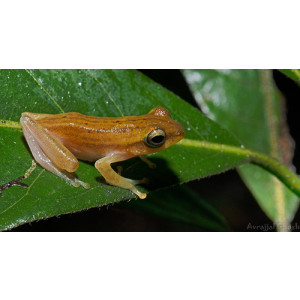Dwarf Bush Frog Did you see this animal?
Scientific Name : Raorchestes parvulus
Family : Rhacophoridae
Order : Anura
Class : Amphibia
Phylum : Chordata
Other Name : Dwarf Bush Frog, Karin, Bubble Nest Frog
Habitat : Nocturnal/Forests
Description : Dwarf bush frog is a very small-sized frog species that is found in the mountain range at elevations ranging from 800 to 2,000 meters above sea level. They inhabit the dense vegetation of moist evergreen forests, often near streams or other bodies of water.
The Anaimalai shrub frog has a distinctive appearance. It has a bright green coloration on the dorsal surface of its body, with small black spots scattered on the skin. The ventral surface is a pale white color. The skin is smooth and moist, typical of frogs that live in moist environments. The head is wider than the body and is pointed with large eyes that have a horizontal pupil. The fingers and toes have expanded tips that help them grip onto vegetation.
These frogs are typically small, measuring only around 20-30 mm in length. The females are slightly larger than the males. They are arboreal, which means they spend most of their time in the trees, clinging to branches and leaves with their sticky toe pads. They are known for their ability to glide from one tree to another, using the flaps of skin between their toes and fingers to catch the air and glide.
This frog is nocturnal and is active during the night when it feeds on insects and other small invertebrates. They are also known to emit a high-pitched call during the mating season. During the monsoon season, which is from June to September. The females lay their eggs on leaves above ponds, and the tadpoles develop in the water. The tadpoles undergo metamorphosis into juvenile frogs after around 40-60 days.
This frog is listed as a species of "Least Concern". However, like many amphibian species, they are threatened by habitat loss due to deforestation and agricultural activities. Conservation efforts are needed to protect their habitats and preserve the Western Ghats biodiversity.
The Anaimalai shrub frog has a distinctive appearance. It has a bright green coloration on the dorsal surface of its body, with small black spots scattered on the skin. The ventral surface is a pale white color. The skin is smooth and moist, typical of frogs that live in moist environments. The head is wider than the body and is pointed with large eyes that have a horizontal pupil. The fingers and toes have expanded tips that help them grip onto vegetation.
These frogs are typically small, measuring only around 20-30 mm in length. The females are slightly larger than the males. They are arboreal, which means they spend most of their time in the trees, clinging to branches and leaves with their sticky toe pads. They are known for their ability to glide from one tree to another, using the flaps of skin between their toes and fingers to catch the air and glide.
This frog is nocturnal and is active during the night when it feeds on insects and other small invertebrates. They are also known to emit a high-pitched call during the mating season. During the monsoon season, which is from June to September. The females lay their eggs on leaves above ponds, and the tadpoles develop in the water. The tadpoles undergo metamorphosis into juvenile frogs after around 40-60 days.
This frog is listed as a species of "Least Concern". However, like many amphibian species, they are threatened by habitat loss due to deforestation and agricultural activities. Conservation efforts are needed to protect their habitats and preserve the Western Ghats biodiversity.
Distribution in Bangladesh
References:
description written by: Md. Shalauddin, Department of Zoology, Jagannath University, Dhaka. Information sources: IUCN Red List Bangladesh-2015, Hasan 2014, Khan 2018 (Photographic guide to the wildlife of Bangladesh).photo credit:siriwatdangsri(www.inaturalist.org/people/siriwatdangsri),photo copyright: iNaturalist. more information please contact with us.
description written by: Md. Shalauddin, Department of Zoology, Jagannath University, Dhaka. Information sources: IUCN Red List Bangladesh-2015, Hasan 2014, Khan 2018 (Photographic guide to the wildlife of Bangladesh).photo credit:siriwatdangsri(www.inaturalist.org/people/siriwatdangsri),photo copyright: iNaturalist. more information please contact with us.



















